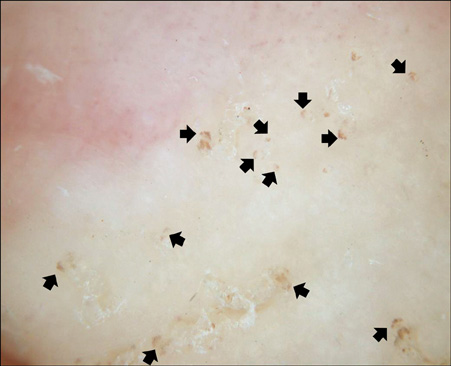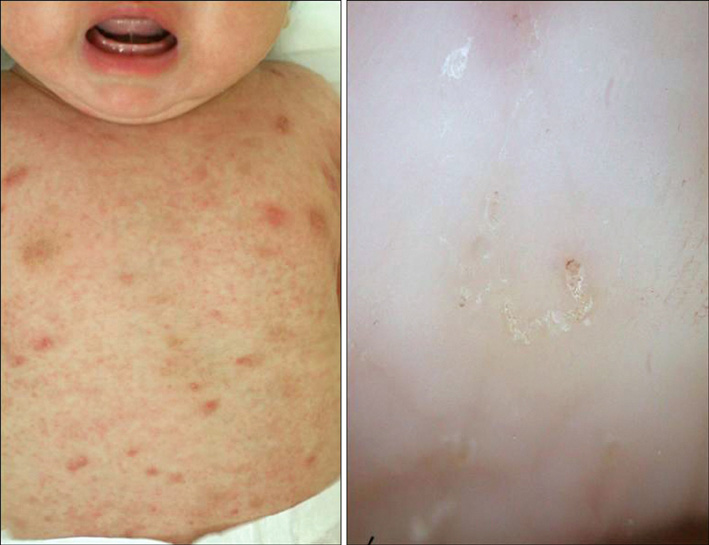Ann Dermatol.
2012 May;24(2):194-199.
The Diagnostic Accuracy of Dermoscopy for Scabies
- Affiliations
-
- 1Department of Dermatology, Kangdong Sacred Heart Hospital, Hallym University College of Medicine, Seoul, Korea. kim937121@naver.com
Abstract
- BACKGROUND
Scabies is a contagious skin infestation characterized clinically by nocturnal pruritus, visible burrows and contagiousness. Dermoscopy has been suggested as an alternative for diagnosing scabies. But, there have been few well-designed studies evaluating the diagnostic accuracy of dermoscopy.
OBJECTIVE
We tried to confirm the diagnostic accuracy of dermoscopy for diagnosing scabies. We also tried to demonstrate specific circumstances in which dermoscopic identification of mites ("with dermoscopy") is more useful in diagnosing scabies, and to identify the specific clinical findings that could be used as a possible marker in diagnosing scabies.
METHODS
We compared the scraping procedure "with dermoscopy" and "without it" in 49 patients, measuring the duration and outcome of each procedure. Also, we tried to find the specific clinical factors associated with our objects.
RESULTS
The skin scraping "with dermoscopy" was superior to "without it" with respect to the duration and accuracy of the procedure. A history of previous steroid treatment was associated with the superiority of dermoscopy. The correlation between the presence of visible burrows and the positive outcomes of "with dermoscopy" was statistically significant.
CONCLUSION
Skin scraping with dermoscopy is implicated as the diagnostic method of choice for scabies at the present time. Dermoscopy is especially useful in diagnosis of incognito scabies. In addition, the presence of visible burrows could be a reliable positive marker of scabies in the absence of dermoscopy or microscopy data.
Keyword
Figure
Reference
-
1. Stone SP, Goldfarb JN, Bacelieri RE. Wolff K, Goldsmith LA, Katz SI, Gilchrest BA, Paller AS, Leffell DJ, editors. Scabies. Fitzpatrick's dermatology in general medicine. 2007. 7th ed. New York: McGraw-Hill;2029–2032.2. Hicks MI, Elston DM. Scabies. Dermatol Ther. 2009. 22:279–292.
Article3. Jin SP, Choi JE, Won CH, Cho S. Scabies in a 2-month-old infant successfully treated with lindane. Ann Dermatol. 2009. 21:200–202.
Article4. Kreusch J. Incident light microscopy: reflections on microscopy of the living skin. Int J Dermatol. 1992. 31:618–620.
Article5. Prins C, Stucki L, French L, Saurat JH, Braun RP. Dermoscopy for the in vivo detection of sarcoptes scabiei. Dermatology. 2004. 208:241–243.
Article6. Walter B, Heukelbach J, Fengler G, Worth C, Hengge U, Feldmeier H. Comparison of dermoscopy, skin scraping, and the adhesive tape test for the diagnosis of scabies in a resource-poor setting. Arch Dermatol. 2011. 147:468–473.
Article7. Dupuy A, Dehen L, Bourrat E, Lacroix C, Benderdouche M, Dubertret L, et al. Accuracy of standard dermoscopy for diagnosing scabies. J Am Acad Dermatol. 2007. 56:53–62.8. Arlian LG, Estes SA, Vyszenski-Moher DL. Prevalence of Sarcoptes scabiei in the homes and nursing homes of scabietic patients. J Am Acad Dermatol. 1988. 19:806–811.
Article9. Lassa S, Campbell MJ, Bennett CE. Epidemiology of scabies prevalence in the U.K. from general practice records. Br J Dermatol. 2011. 164:1329–1334.
Article10. Jackson A, Heukelbach J, Feldmeier H. Transmission of scabies in a rural community. Braz J Infect Dis. 2007. 11:386–387.
Article11. Wendel K, Rompalo A. Scabies and pediculosis pubis: an update of treatment regimens and general review. Clin Infect Dis. 2002. 35:Suppl 2. S146–S151.
Article
- Full Text Links
- Actions
-
Cited
- CITED
-
- Close
- Share
- Similar articles
-
- Diagnostic Accuracy of Dermoscopy for Scabies
- Four Cases of Infantile Nodular Scabies: The Usefulness of Dermoscopy for in Vivo Detection of Scabies
- Effective Diagnosis and Treatment of Scabies in Cases from 3 Generations Using Dermoscopy-oriented Skin Scraping with Microscopic Examination
- Effectiveness of Cytochrome c Oxidase Subunit 1 Gene Nested Polymerase Chain Reaction Compared to Dermoscopy or Microscopy Alone for the Detection and Diagnosis of Sarcoptes scabiei var. hominis Infection
- Xanthogranuloma for Whom Dermoscopy Was Used as an Adjuvant Diagnostic Tool



